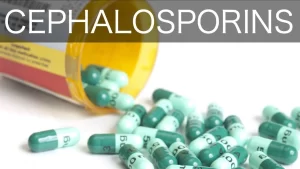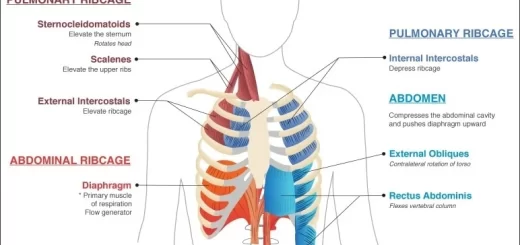Cephalosporins antibiotics types, examples, Carbapenems, Monobactams and Glycopeptides
Cephalosporins are a class of β-lactam antibiotics originally derived from the fungus Acremonium, they are used to manage a wide range of infections from gram-positive and gram-negative bacteria, Cephalosporin was known as Cephalosporium, Together with cephamycins, they constitute a subgroup of β-lactam antibiotics called cephems.
Cephalosporins
Cephalosporins are beta-lactam antimicrobials, They are grouped into five generations based on their spectrum of antimicrobial activity, Each newer generation of cephalosporins has a significantly broader Gram-negative antimicrobial spectrum than the preceding generation, and in most cases decreased activity against Gram-positive organisms.
Fourth generations, however, have the broadest spectrum activity, The fifth-generation cephalosporin has activity against many Gram-positive organisms (including MRSA and many other resistant Gram-positives), as well as some Gram-negative organisms (but not Pseudomonas).
Pharmacokinetics
Absorption: Many of cephalosporins must be administered parenterally because of their poor oral absorption.
Distribution: All cephalosporins distribute very well into body fluids. However, adequate therapeutic levels in the CSF, regardless of inflammation are achieved with only a few cephalosporins, e.g. ceftriaxone, and cefotaxime.
Elimination: Cephalosporins are eliminated through the kidney, therefore, doses must be adjusted in cases of renal dysfunction. However, ceftriaxone and cefoperazone are excreted through the bile into the feces, therefore they are frequently used in patients with insufficiency.
First Generation Cephalosporins
Includes: cefazolin. cephalexin
Spectrum
They are effective against some Gram-positive organisms, including Streptococci and Staph aureus, Some Gram-negative organisms, including Proteus mirabilis E. coli, Klebsiella, They are resistant to staphylococcal penicillinase, but they cover MSSA.
Therapeutic uses
- Staphylococcal or streptococcal skin and soft tissue infections.
- Surgical prophylaxis: Intravenous narrow-spectrum cefazolin should be started within 60 minutes before the surgical incision.
- Uncomplicated cystitis: oral cephalexin for seven days is recommended for uncomplicated cystitis.
They do not cross the meninges; thus, they are not used for the treatment of meningitis.
Second Generation Cephalosporins
Includes: cefaclor, cefuroxime.
Spectrum
They have the following antimicrobial activity:
- Greater activity against Gram-negative organisms, including H. influenzae, and proteus mirabilis E. coli. Klebsiella, They are active against beta-lactamase-producing H. influenzae and Moraxella catarrhalis.
- Weaker activity against Gram-positive organisms, e.g. Streptococci, They do not penetrate the meninges.
Therapeutic uses
- Since the oral second-generation cephalosporins are active against beta-lactamase-producing H influenzae and Moraxella catarrhalis, thus they are used to treat sinusitis and otitis media.
- Community-acquired pneumonia because of their activity against beta-lactamase-producing H. influenzae or K pneumoniae, and some penicillin-non-susceptible Pneumococci.
- Uncomplicated cystitis.
Third Generation Cephalosporins
Includes: ceftriaxone cefotaxime, ceftazidime.
Spectrum
They have the following antimicrobial activity:
- Greater activity against Gram-negative organisms: H influenzae, Neisseria, Proteus mirabilis, E.coli, and Klebsiella, They are active against beta-lactamase-producing strains of H. influenzae and Neisseria.
- Moderate activity against anaerobes.
- Weaker activity against Gram-positive organisms e.g., Streptococci.
N.B:
- Ceftazidime and cefoperazone have an anti-pseudomonal activity.
- Ceftriaxone and cefotaxime have excellent penetration into the CSF.
Therapeutic uses
- Ceftriaxone and cefotaxime are approved for the treatment of meningitis, However, highly penicillin-resistant strains may not respond even to these agents, and the addition of vancomycin is recommended.
- Community-acquired and hospital-acquired pneumonia.
- Complicated urinary tract infection.
- Sepsis of unknown cause in both the immunocompetent and the immunocompromised patient.
- Gonorrhea: intramuscular ceftriaxone as a single dose PLUS a single oral dose of azithromycin (azithromycin is added to increase the efficacy against Neisseria gonorrhea and for the most likely associated chlamydial coinfection).
- Typhoid fever: parenteral ceftriaxone or oral cefixime are used.
Fourth Generation Cephalosporins: Cefepime
Spectrum
They have the broadest spectrum of activity on Gram-negative, including Pseudomonas, and similar activity against Gram-positive organisms to that of the first generation. They have a greater resistance to beta-lactamases than third-generation cephalosporins. They have weak anaerobe coverage.
Therapeutic uses
- Hospital-acquired pneumonia.
- Complicated urinary tract infection.
Fifth Generation Cephalosporins: Ceftaroline
Spectrum
Ceftaroline is unique in its activity against multidrug-resistant Staphylococcus aureus, including MRSA and Vancomycin-resistant S, aureus (VRSA), It has a similar Gram-negative coverage to the third generation with no Pseudomonas coverage.
Therapeutic uses
Empiric treatment of infections where MRSA is among suspected microorganisms, e.g., acute bacterial skin and skin structure infections
Adverse Reactions of cephalosporins
- Allergic reactions.
- Gastrointestinal upsets.
- Superinfection: They might predispose to infection by other bacteria or fungi.
Patients with a history of penicillin allergy may tolerate cephalosporins, but patients with a history of anaphylaxis to penicillin should never receive cephalosporins.
Carbapenems
They include imipenem/cilastatin, meropenem, and ertapenem.
Spectrum
They have the following antimicrobial activity against:
- Gram-negative bacteria, including Enterobacteriaceae family and Pseudomonas aeruginosa.
- Anaerobes, like Bacteroides fragilis.
- Gram-positive bacteria, such as Staphylococcus aureus and Streptococci.
- They are resistant to most lactamases.
Pharmacokinetics
They are given parenterally either by the intravenous or intramuscular route, They penetrate well body tissues and fluids, including the CSF, Imipenem is metabolized extensively by dihydro-peptidase I in the brush border of the proximal renal tubular cells and the metabolite is excreted in the urine, Cilastatin offers protection against dihydropeptidase I, increasing the urinary excretion of intact imipenem, They depend mainly on renal elimination. Dose adjustment is required in patients with renal impairments.
Therapeutic Uses
Many are serious due to resistant Gram-negative organisms and mixed aerobic/anaerobic organisms, including hospital-acquired meningitis and intra-abdominal infections.
Adverse Reactions
- Super-infection could lead to diarrhea.
- Central nervous system toxicity, Excessive levels of imipenem in patients with renal failure may lead to seizures. Meropenem and ertapenem are much less likely to cause seizures.
Contraindications: Patients, who have severe penicillin hypersensitivity, should not receive carbapenems.
Monobactams: Aztreonam
Spectrum
It has a narrow antibacterial spectrum. It is active only against Gram-negative aerobic bacilli including Pseudomonas aeruginosa. It is resistant to beta-lactamases. It has no activity against Gram-positive bacteria or anaerobes.
Pharmacokinetics
Aztreonam is given intravenously. It is cleared by the kidney, therefore, dose adjustment is required in renal impairment.
Therapeutic uses
It can be given to patients allergic to penicillin or cephalosporins, It has no cross-sensitivity with penicillin.
Glycopeptides
1. Vancomycin
Spectrum: Vancomycin is a bactericidal time-dependent antibiotic. It is active only against Gram-positive bacteria including MRSA.
Pharmacokinetics. It is not significantly absorbed from the normal gastro-intestinal tract, therefore, it is given parenterally as a slow intravenous injection or intravenous infusion. It is eliminated by the Kidney, thus, the dose should be adjusted according to creatinine clearance.
Therapeutic Uses
- Infections caused by MRSA.
- Vancomycin is used in combination with Gentamicin for the treatment of enterococcal endocarditis in penicillin-allergic patients, Third generation cephalosporins for the treatment of meningitis caused by penicillin-resistant pneumococci.
- It is used orally for the treatment of Staphylococcal enterocolitis and pseudomembranous colitis due to Clostridium difficile.
Adverse Reactions
Irritation leads to phlebitis at the site of infection.
Ototoxicity: Vestibular damage and/or cochlear damage associated with tinnitus and sensorineural hearing loss have been reported. It is more likely to occur with larger doses given to an older patient. The patients could present by dizziness, tinnitus, and decreased hearing perception. Ototoxicity has even been reported with oral vancomycin.
Nephrotoxicity: Acute kidney injury is more likely to occur in the following condition: use of larger doses and longer duration of vancomycin administration. Concurrent use of other agents with potential nephrotoxicity. Such agents include piperacillin-tazobactam and aminoglycosides. In critically ill patients, who are susceptible to poor renal perfusion.
Histamine release leads to Red man syndrome, if given by rapid intravenous infusion. It can be prevented by slow intravenous infusion over 1-2 hours.
2. Teicoplanin
It is a useful antimicrobial agent with a similar spectrum of antimicrobial activity to vancomycin, but resistant organisms to either antibiotics are sometimes sensitive to the other.
Advantages over vancomycin: It only needs to be given once a day, does not need to be given as slowly as vancomycin, and can be given by intramuscular injection. Also, it is less nephrotoxic and is preferred in the patient at high risk of acute kidney injury.
Bacitracin
It is a polypeptide antibiotic, used against Gram-positive bacteria usually topically with neomycin and polymyxins to prevent superficial skin and eye infections.
You can follow science online on Youtube from this link: Science online
You can download Science online application on google Play from this link: Science online Apps on Google Play
Antibacterial drugs definition, use & types, Penicillin classification & importance
Chemoprophylaxis indications, definition, examples & Causes of Misuse of antimicrobial drugs
Antimicrobial drugs types, use, side effects, resistance & Empiric antimicrobial therapy
Parasitic infections, Immunological tests, DNA probes and Polymerase Chain Reaction
Diagnosis of parasitic infections and Techniques used for identification of Intestinal Parasites
Vaccines types, Live vaccines, Inactivated vaccines, Subunit vaccines, Naked DNA & mRNA vaccines




